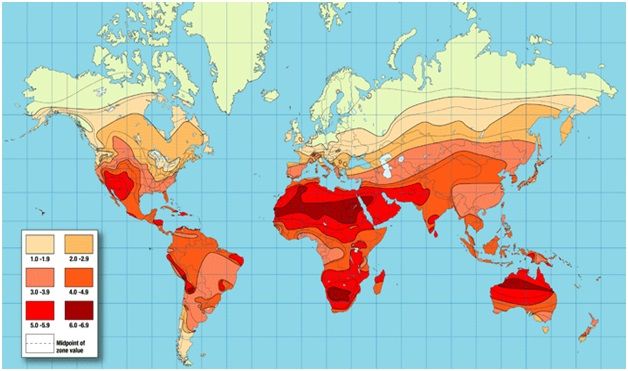How Many Solar Panels do I need to power my house?

Where do I start?
There are a few things you need to decide before you begin thinking about how many panels you need for in your Solar PV Package. Will your system be off or on grid? Will it use a string inverter, micro inverter, or hybrid inverter? These choices are not necessarily going to affect how many panels you will need so we will not dive into their differences in this article. Just know that these choices will need to be made before you calculate how many panels your system will need.
What do I need to know to decide how many PV panels my system needs?
When installing a solar PV system, there are four main variables that will dictate the number of solar panels you need. Let’s discuss them.
PV panel wattage/efficiency
Solar PV panels are rated by their efficiency. Normal residential PV panels usually have an efficiency rating between 12-18%. A panel’s efficiency determines its maximum watts it can produce per its area of size. Say a panel is 15% efficient, this would mean that out of the theoretical maximum of 1000 watts/square meter of sunlight that could fall onto a panel, 15% or 150 watts/m2 can be harnessed. Now if the panel’s size is 1.5 m2 in size we could then produce 150 watts x 1.5 m2 (225 Watts). That’s 225 watts peak rating, which means that only in the most optimal and perfect conditions would the panel produce this wattage.
When you buy solar PV panels, they will have a wattage rating, and as a rule of thumb the more efficient the panels are, the less of them you will need for your solar system given the same area of space. By increasing the size of the panel or increasing the efficiency, the manufacture rating will go up. If space is limited then we want more efficient panel to maximize the space, however, efficiency costs money so there is a balance between cost, efficiency and size that we need to consider when choosing a panel and its size.
Your home’s electricity bill
The electricity you use at home will determine how many panels your system needs. Electricity usage is measured in kilowatts hours. Using PV panels is meant to subsidize your electricity bill, or at least part of it, so your average monthly electricity usage is obviously a big part in determining the number of panels you will need. Look at your past electricity bills to find your average monthly kilowatt usage. An average bill would be around 600kwh per month, but of course that will vary depending on your electricity usage and home location.
The percentage of your electricity usage you want to subsidize with solar PV
After you have figured out how much electricity you are using at home, you will need to consider how much of that electricity usage you want to subsidize using solar PV. If you want your entire home powered exclusively by solar PV, then you would need to have enough panels to take care of 100% of your electricity needs. Maybe you only want to subsidize 50% of your electricity bill with solar, or maybe just your hot water tank (which usually accounts for 25% of your electricity bill). It goes without saying that the higher percentage of your electricity usage you want to subsidize with solar, the more panels you will need.
The amount of peak sun hours your home receives
Different locations have varying amounts of Peak Sun Hours. Peak Sun Hours is the equivalent number of hours per day where the solar irradiance averages 1000w/m2. So, in each if an average of 4000w/m2 falls on a location it would be said to have 4 Peak Sun Hours (4000/1000). This is important as your solar panels are rated on peak sunlight hours (1000w/m2) as we mentioned above. So, if we know we have 4 Peak Sun Light Hours and we know our panels are rated at 250-watts (per peak sunlight hour) then we know we can expect 1000 watts of power per 250 watt collector. 4 peak hours x 250 watt peak = 1000W. If your home is in a location that receives a lot of peak sun hours on average, say 6 sun hours like in the Arizona desert, you would need less PV panels to produce the same amount of electricity as a home in the northwest coast that has an average of 4 peak sun hours a day. A quick internet search is all you need to determine the amount of peak sun hours your home receives.

Example of Global Peak Sun Hour Map
Putting these variables together
So now that you have determined your home electricity usage, the percentage of that usage you want solar PV to cover, the amount of peak sun hours your home receives, and the efficiency/wattage rating of the panels you want to use, how do you determine how many panels your solar PV system would need? The easiest way to determine this is by searching for a solar panel calculator on the internet. These calculators make the calculation very simple, all you have to do is plug in your variable values and the calculator will suggest the number of panels you will need. PV Watts is the industry leading calculator and is free (Google it).
Here is the math these calculators use:
X = KWH/year
Y = Percentage of X you want subsidized by Solar PV
S = Total annual amount of solar to produce
H = Peak sun hours in your location average/year
Ha = Total annual solar hours
W = wattage rating of the PV panels you want to use
Yw = Watts produced annual per panel
Yk = Kw produced annually per panel
T = Number of solar panels you will need (*rounded up to whole number)
- X * Y = S (Target annual solar)
- H * 365 = Ha (Annual solar hours)
- W * Ha = Yw (Year production solar per collector in watts)
- Yw/1000 = Yk (Year production solar per collector in Kw)
- S/Yk =T (Total Panels required)
Example
X=12,000 Kwh/year
Y=50%
H=4.5 kWhr/m2/day average
W=250Watt
- 12,000 x 50% = 6000 Kw (annually)
- 4.5 x 365 = 1642.5 hr (annual solar hours)
- 250 x 1642.5 = 410,625 watts
- 410,625/1000 = 410.5 Kw
- 6000/410 = 14.6 T (round up) 15 x 250 Watt Panels
System Loss
This is in a perfect world which we don’t live in! We know there are other losses that will occur such as line loss, dirty panels, inverter loss to name a few. Most calculators use an average of 15% to factor in misc. loss so in the example above the 15 panels required to produce 6000 Kw annually would be more like 18 panel required.



